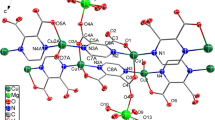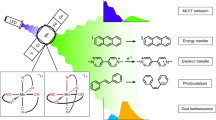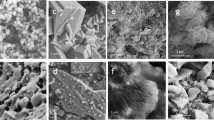Abstract
THE detergents of the next century will be routinely required to contain bleaching agents that are not only more active than those currently available but also environmentally safe and cost-effective. Hydrogen peroxide, the traditional bleaching agent1, loses its activity as the washing temperature decreases. Peroxyacetic acid maintains acceptable bleaching activity down to 40–60 °C (ref. 2), but still lower temperatures are desirable. It is generally recognized that manganese and iron complexes are less environmentally damaging reagents than other transition-metal compounds, and such complexes have received considerable attention as bleaching catalysts3–11. Here we show that manganese complexes derived from l,4,7-trimethyl-l,4,7-triazacyclononane and related ligand systems act as highly effective catalysts for the bleaching of stains by hydrogen peroxide at low temperatures. These complexes also catalyse the epoxidation of alkenes and the oxidation of poh phenolic substrates by hydrogen peroxide. Our results demonstrate the considerable potential of these systems for clean and efficient low-temperature bleaching.
This is a preview of subscription content, access via your institution
Access options
Subscribe to this journal
Receive 51 print issues and online access
$199.00 per year
only $3.90 per issue
Buy this article
- Purchase on Springer Link
- Instant access to full article PDF
Prices may be subject to local taxes which are calculated during checkout
Similar content being viewed by others
References
Engel, K., Ruback, W. & Zimmermann, F. Siefen Ōle Fette Wachse 115, 219–224 (1989).
Becker, G. Tenside Deterg. 13, 16–17 (1976).
Farre, T. L. F. et al., European Patent Application Nos 458,397 (1991) and 458,398 (1991).
Oakes, J., European Patent Application Nos 127,910 (1984) and 145,091 (1985).
Pecoraro, V. L. (ed.) Manganese Redox Enzymes (VCH, New York, 1992).
Dismukes, C. G. in Bioinorganic Catalysis (ed. Reedijk, J.) 317–346 (Dekker, New York, 1993).
Wieghardt, K. Angew. Chem. int. Edn engl. 28, 1153–1172 (1989).
Bossek, U., Saher, M., Weyhermüller, T. & Wieghardt, K. J. chem. Soc., chem. Commun. 1780–1782 (1992).
Larson, E. J. & Pecoraro, V. L. J. Am. chem. Soc. 113, 3810–3818 (1991).
Nam, W. & Valentine, J. S. J. Am. chem. Soc. 115, 1772–1778 (1993).
Guajardo, R. J., Hudson, S. E., Brown, S. J. & Mascharak, P. K., J. Am. chem. Soc. 115, 7971–7977 (1993).
Wieghardt, K. et al. J. Am. chem. Soc. 110, 7398–7411 (1988).
Bossek, U., Weyhermüller, T., Wieghardt, K., Nuber, B. & Weiss, J. J. Am. chem. Soc. 112, 6387–6388 (1990).
Weighardt, K., Pohl, K., Bossek, U., Nuber, B. & Weiss, J. Z. Natuurf. 43b, 1184–1194 (1988).
Belal, A. A. et al., Inorg. Chem. 30, 4397–4402 (1991).
Finger, A., Kuhr, S. & Engelhardt, U. H. J. Chromatogr. 624, 293–315 (1992).
Dismukes, G. C. in Mixed-Valence Systems: Applications in Chemistry, Physics and Biology (ed. Prassides, K.) 137–154 (Kluwer, Dordrecht, 1991).
Weyermüller, T. & Wieghardt, K. J. inorg. Biochem. 43, 371 (1991).
Author information
Authors and Affiliations
Rights and permissions
About this article
Cite this article
Hage, R., Iburg, J., Kerschner, J. et al. Efficient manganese catalysts for low-temperature bleaching. Nature 369, 637–639 (1994). https://doi.org/10.1038/369637a0
Received:
Accepted:
Issue Date:
DOI: https://doi.org/10.1038/369637a0
This article is cited by
-
Organic buffers act as reductants of abiotic and biogenic manganese oxides
Scientific Reports (2023)
-
Synthesis, characterization and catalytic activity of novel monometallic and bimetallic Mn(II) complexes with thiocarboxamide and phenanthroline ligands
Transition Metal Chemistry (2023)
-
N,N′-diethyl and N-ethyl,N′-methyl glyoxal-bridged cyclams: synthesis, characterization, and bleaching activities of the corresponding Mn(II) complexes
Transition Metal Chemistry (2017)
-
Chemical and structural changes associated with Cu-catalyzed alkaline-oxidative delignification of hybrid poplar
Biotechnology for Biofuels (2015)
-
Model system for mechanistic study of catalytic bleaching of cotton
Fibers and Polymers (2010)
Comments
By submitting a comment you agree to abide by our Terms and Community Guidelines. If you find something abusive or that does not comply with our terms or guidelines please flag it as inappropriate.



